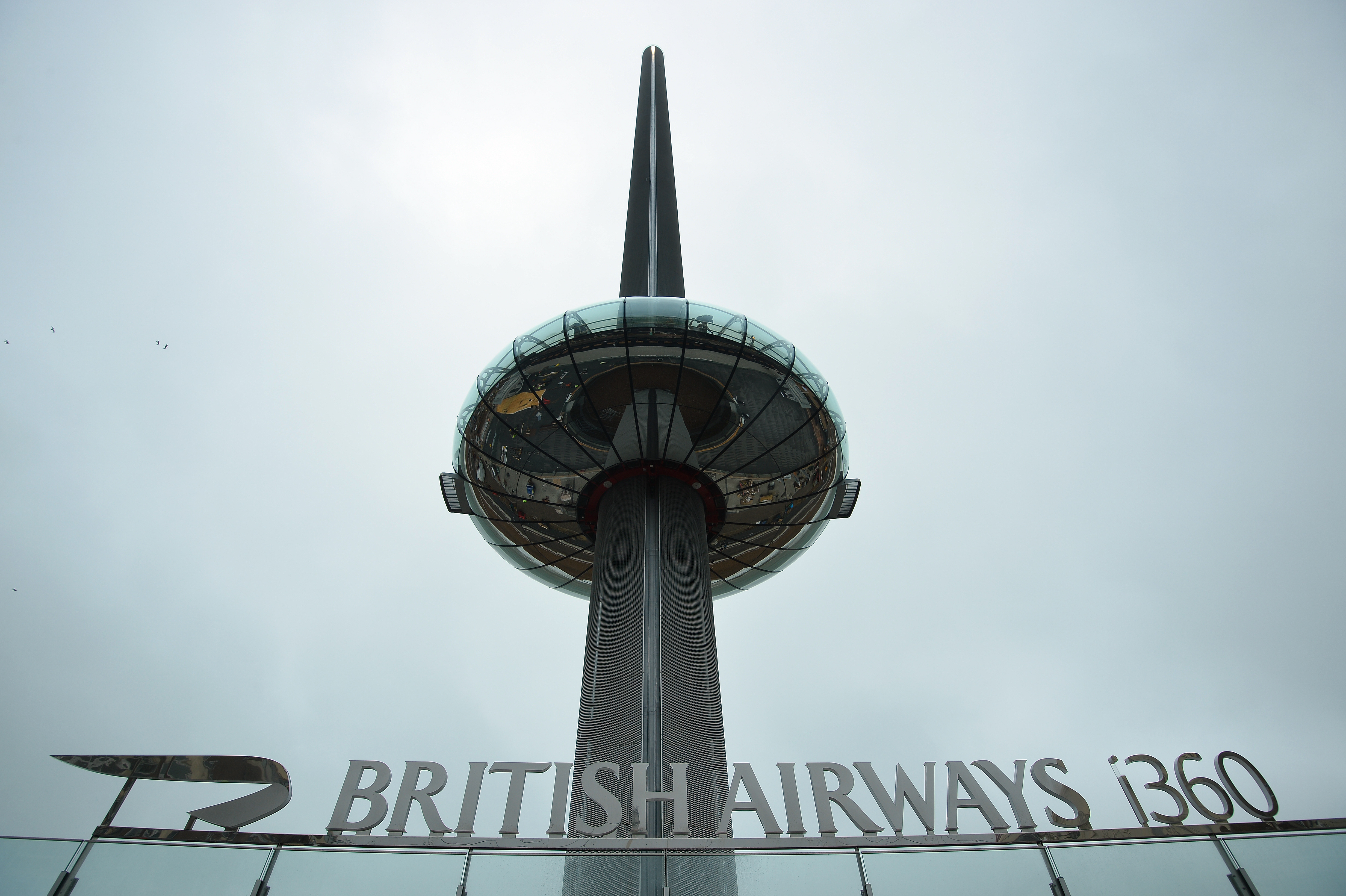
The verticle cable car that ascends to a height of 450 feet (132 meters) affords 360-degree views of up to 26 miles, according to the attractions website. The observation tower opens officially on August 4, 2016. / AFP PHOTO /
by Robin MILLARD
BRIGHTON, United Kingdom (AFP) — The world’s tallest moving observation tower, the i360, opens to the public on Thursday, a futuristic landmark that has transformed the historic seafront in the English tourist resort of Brighton.
A 162-meter (530-foot) high steel tower is ringed by a doughnut-shaped glass observation pod that gently glides up and down.
The design is meant to be a 21st-century take on the Victorian pleasure piers that characterize British seaside towns: this time, a vertical pier in the sky, according to project chiefs.
It is hoped that the attraction will further boost tourism in the southeastern resort of Brighton, a gem of 1700s and 1800s architectural grandeur.
Designed by David Marks and Julia Barfield, the tower is the sequel to their London Eye observation wheel, which opened in the British capital in 2000 and is one of its most popular visitor attractions.
Several places wanted a copy of the giant wheel, but the husband-and-wife team felt the concept wasn’t viable in smaller cities.
Instead they took the chance to recalibrate it for Brighton, already Britain’s most popular seaside destination for foreign tourists, in this project that has taken 13 years of work to come to fruition.
“The key ingredient, as with the London Eye, is moving very slowly to a great height for a fantastic view,” said Barfield.
‘The architecture of pleasure’
The i360 sits at the entrance to the 1866-built West Pier, which burnt down in 2003.
With a height to diameter ratio of 40 to one, it is the world’s slenderest tall tower, according to Guinness World Records.
“This is very much in the spirit of the West Pier, whose purpose was to delight, entertain and inspire people,” Marks told AFP, standing at the top of the tower.
“Just as it invited Victorian society to go out and walk on water, the i360 turns that concept vertically and invites people to walk on air and get a new perspective on the city.
“Everybody seems to love a great view,” he added.
“It’s a pleasure both to the eyes and the intellect not only to gaze at the horizons but to look beyond them.”
The tower cost £46 million ($61 million, 55 million euros) to build but promises to break even as long as it attracts around half its estimated annual 700,000 visitors.
From the top, visitors can see for 26 miles (42 kilometers) along the coast and out over the English Channel.
Until now, the Royal Pavilion has been Brighton’s standout landmark: an over-the-top, mock Indian palace completed in 1823 as a seaside residence for King George IV, who was known for his indulgent lifestyle.
The Sussex city is also known for its Georgian and Regency terraces, as well as its later Victorian piers, and is now home to an up-and-coming arty crowd and is often considered Britain’s “gay capital”.
The tower’s designers say the new structure, which dominates the city’s skyline, is in keeping with Brighton’s history of bold architecture built for pleasure, but it has not been universally welcomed by locals.
The tower’s nicknames range from the “iSore” to more sexually innuendoed names, and some residents decry the local authority taking on a £36 million loan to fund the project — though the city council insists it is charging the i360 a higher rate than the borrowing costs.
Alien spacecraft-style pod
The 18-metre diameter pod — technically an oblate ellipsoid shape — is pulled up by a giant cog and steel cable winch system, located underground. It also uses a counterweight within the tower.
Christian Bouvier, vice-president of French cable car experts Poma, which built the pod and the drive mechanism, said the vertical lift system was a new technical challenge for the company.
“This has never been done before,” he told AFP.
The 200-capacity pod looked like a visiting alien spacecraft when first assembled next to a cornfield in France, Bouvier said.
Looking out from his maiden ride in the pod, he said: “It’s really the wow effect. It is sensational to see, as if in a helicopter.”
Bouvier compared the i360 to Paris’s most famous tower.
“David Marks is really the Gustave Eiffel of our century,” he claimed.
The tower’s lattice steel cladding is designed to diffuse the wind so that it does not wobble, and to protect it from expanding in the sun.
“The results of this actually turned out better than the theory,” said Bouvier.
The pod will travel up and down around 200 times a week, starting in September, and cost visitors £15 ($20, 18 euros) a ride.
© 1994-2016 Agence France-Presse







